|
[1]
|
[ J. P. Aparicio,C. Castillo-Chavez, Mathematical modelling of tuberculosis epidemics, Mathematical Biosciences and Engineering, 6 (2009): 209-237.
|
|
[2]
|
[ Z. Bai, Threshold dynamics of a time-delayed SEIRS model with pulse vaccination, Mathematical Biosciences, 269 (2015): 178-185.
|
|
[3]
|
[ S. M. Blower,T. Chou, Modeling the emergence of the 'hot zones': Tuberculosis and the amplification dynamics of drug resistance, Nature Medicine, 10 (2004): 1111-1116.
|
|
[4]
|
[ S. M. Blower,P. M. Small,P. C. Hopewell, Control strategies for tuberculosis epidemic: New models for old problems, Science, 273 (1996): 497-500.
|
|
[5]
|
[ S. Bowong,J. J. Tewa, Global analysis of a dynamical model for transmission of tuberculosis with a general contact rate, Communications in Nonlinear Science and Numerical Simulation, 15 (2010): 3621-3631.
|
|
[6]
|
[ H. Cao,Y. Zhou, The discrete age-structured SEIT model with application to tuberculosis transmission in China, Mathematical and Computer Modelling, 55 (2012): 385-395.
|
|
[7]
|
[ C. Castillo-Chavez,Z. Feng, To treat or not treat: The case of tuberculosis, Journal of Mathematical Biology, 35 (1997): 629-656.
|
|
[8]
|
[ C. Castillo-Chavez,Z. Feng, Global stability of an age-structure model for TB and its applications to optimal vaccination strategies, Mathematical Biosciences, 151 (1998): 135-154.
|
|
[9]
|
[ C. Castillo-Chavez,B. Song, Dynamical models of tuberculosis and their applications, Mathematical Biosciences and Engineering, 1 (2004): 361-404.
|
|
[10]
|
[ H. Chang, Quality monitoring and effect evaluation of BCG vaccination in neonatus, Occupation and Health, 9 (2013): 1109-1110.
|
|
[11]
|
[ O. Diekmann,J. A. P. Heesterbeek,J. A. J. Metz, On the definition and the computation of the basic reproduction ratio R0 in models for infectious diseases in heterogeneous populations, Journal of Mathematical Biology, 28 (1990): 365-382.
|
|
[12]
|
[ P. V. D. Driessche,J. Watmough, Reproduction numbers and sub-threshold endemic equilibria for compartmental models of disease transmission, Mathematical Biosciences, 180 (2002): 29-48.
|
|
[13]
|
[ M. J. Keeling,P. Rohani, null, Modeling Infectious Diseases in Humans and Animals, Princeton University Press, 2008.
|
|
[14]
|
[ J. Li, The spread and prevention of tuberculosis, Chinese Remedies and Clinics, 13 (2013): 482-483.
|
|
[15]
|
[ L. Liu,X. Zhao,Y. Zhou, A tuberculosis model with seasonality, Bulletin of Mathematical Biology, 72 (2010): 931-952.
|
|
[16]
|
[ J. S. Lopes, P. Rodrigues, S. T. Pinho, R. F. Andrade, R. Duarte and M. G. M. Gomes, Interpreting Measures of Tuberculosis Transmission: A Case Study on the Portuguese Population, BMC Infectious Diseases, 2014.
|
|
[17]
|
[ Z. Lu,X. Chi,L. Chen, The effect of constant and pulse vaccination on SIR epidemic model with horizontal and vertical transmission, Mathematical and Computer Modelling, 36 (2002): 1039-1057.
|
|
[18]
|
[ National Bureau of Statistics of China, Statistical Data of Tuberculosis 2004-2014. Available from: http://data.stats.gov.cn/easyquery.htm?cn=C01&zb=A0O0F01.
|
|
[19]
|
[ National Bureau of Statistics of China, China Statistical Yearbook 2014, Birth Rate, Death Rate and Natural Growth Rate of Population, 2014. Available from: http://www.stats.gov.cn/tjsj/ndsj/2014/indexch.htm.
|
|
[20]
|
[ National Technic Steering Group of the Epidemiological Sampling Survey for Tuberculosis, Report on fourth national epidemiological sampling survey of tuberculosis, Chinese Journal of Tuberculosis and Respiratory Diseases, 25 (2002), 3-7.
|
|
[21]
|
[ A. M. Samoilenko,N. A. Perestyuk, Periodic and almost-periodic solution of impulsive differential equations, Ukrainian Mathematical Journal, 34 (1982): 66-73,132.
|
|
[22]
|
[ A. M. Samoilenko and N. A. Perestyuk, Differential Equations with Impulse Effect, Visa Skola, Kiev, 1987.
|
|
[23]
|
[ O. Sharomi,C. N. Podder,A. B. Gumel,B. Song, Mathematical analysis of the transmission dynamics of HIV/TB coinfection in the presence of treatment, Mathematical Biosciences and Engineering, 5 (2008): 145-174.
|
|
[24]
|
[ M. Shen, Y. Xiao, W. Zhou and Z. Li, Global dynamics and applications of an epidemiological model for hepatitis C virus transmission in China, Discrete Dynamics in Nature and Society, 2015 (2015), Article ID 543029, 13pp.
|
|
[25]
|
[ B. Shulgin,L. Stone,Z. Agur, Pulse vaccination strategy in the SIR epidemic model, Bulletin of Mathematical Biology, 60 (1998): 1123-1148.
|
|
[26]
|
[ B. Song,C. Castillo-Chavez,J. P. Aparicio, Tuberculosis models with fast and slow dynamics: The role of close and casual contacts, Mathematical Biosciences, 180 (2002): 187-205.
|
|
[27]
|
[ Technical Guidance Group of the Fifth National TB Epidemiological Survey and The Office of the Fifth National TB Epidemiological Survey, The fifth national tuberculosis epidemiological survey in 2010, Chinese Journal of Antituberculosis, 34 (2012), 485–508.
|
|
[28]
|
[ E. Vynnycky,P. E. M. Fine, The long-term dynamics of tuberculosis and other diseases with long serial intervals: Implications of and for changing reproduction numbers, Epidemiology and Infection, 121 (1998): 309-324.
|
|
[29]
|
[ WHO, Global Tuberculosis Report 2015, World Health Organization, 2015. Available from: http://www.who.int/tb/publications/global_report/en/.
|
|
[30]
|
[ WHO, Tuberculosis Vaccine Development, 2015. Available from: http://www.who.int/immunization/research/development/tuberculosis/en/.
|
|
[31]
|
[ C. Xiong,X. Liang,H. Wang, A Systematic review on the protective efficacy of BCG against children tuberculosis meningitis and millet tuberculosis, Chinese Journal of Vaccines and Immunization, 15 (2009): 359-362.
|
|
[32]
|
[ B. Xu,Y. Hu,Q. Zhao,W. Wang,W. Jiang,G. Zhao, Molecular epidemiology of TB -Its impact on multidrug-resistant tuberculosis control in China, International Journal of Mycobacteriology, 4 (2015): 134.
|
|
[33]
|
[ Y. Yang,S. Tang,X. Ren,H. Zhao,C. Guo, Global stability and optimal control for a tuberculosis model with vaccination and treatment, Discrete and Continuous Dynamical Systems -Series B, 21 (2016): 1009-1022.
|
|
[34]
|
[ Y. Zhou,K. Khan,Z. Feng,J. Wu, Projection of tuberculosis incidence with increasing immigration trends, Journal of Theoretical Biology, 254 (2008): 215-228.
|
|
[35]
|
[ E. Ziv,C. L. Daley,S. M. Blower, Early therapy for latent tuberculosis infection, American Journal of Epidemiology, 153 (2001): 381-385.
|










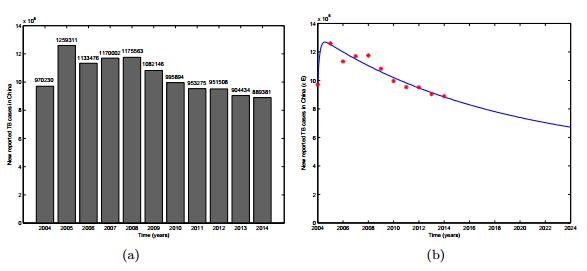
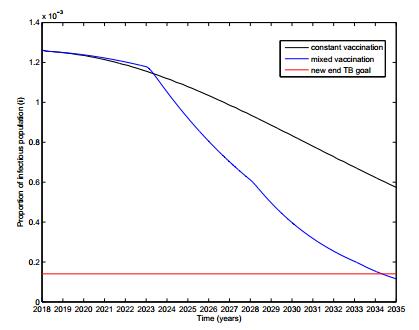
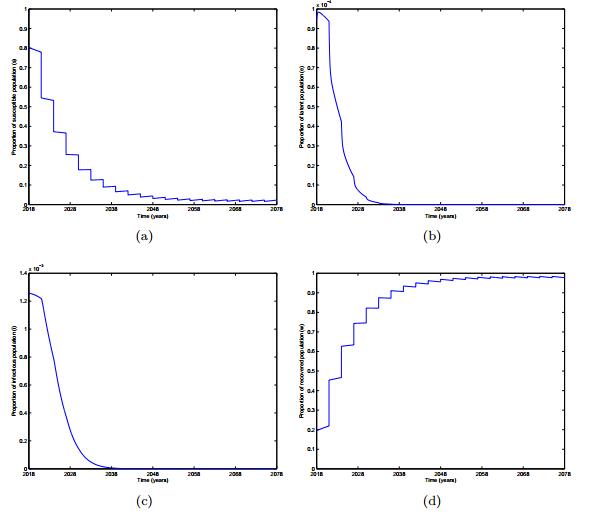
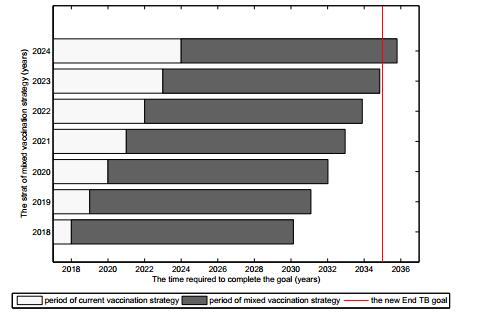
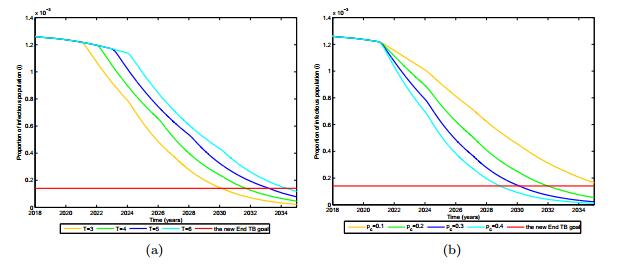


 DownLoad:
DownLoad: